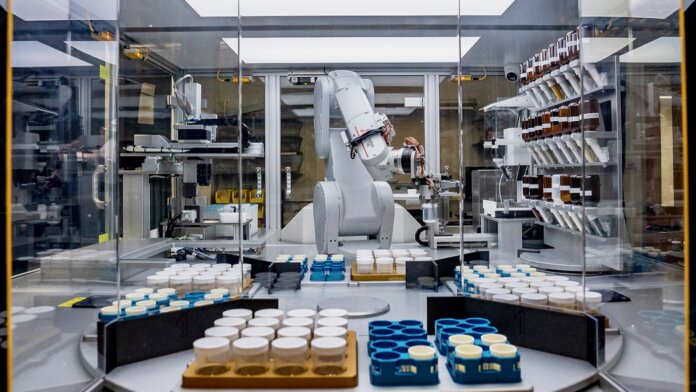A robot chemist just teamed up with an AI brain to create a trove of new materials.
Two collaborative studies from Google DeepMind and the University of California, Berkeley, describe a system that predicts the properties of new materials—including those potentially useful in batteries and solar cells—and produces them with a robotic arm.
We take everyday materials for granted: plastic cups for a holiday feast, components in our smartphones, or synthetic fibers in jackets that keep us warm when chilly winds strike.
Scientists have painstakingly discovered roughly 20,000 different types of materials that let us build anything from computer chips to puffy coats and airplane wings. Tens of thousands more potentially useful materials are in the works. Yet we’ve only scratched the surface.
The Berkeley team developed a chef-like robot that mixes and heats ingredients, automatically transforming recipes into materials. As a “taste test,” the system, dubbed the A-Lab, analyzes the chemical properties of each final product to see if it hits the mark.
Meanwhile, DeepMind’s AI dreamed up myriad recipes for the A-Lab chef to cook. It’s a hefty list. Using a popular machine learning strategy, the AI found two million chemical structures and 380,000 new stable materials—many counter to human intuition. The work is an “order-of-magnitude” expansion on the materials that we currently know, the authors wrote.
Using DeepMind’s cookbook, A-Lab ran for 17 days and synthesized 41 out of 58 target chemicals—a win that would’ve taken months, if not years, of traditional experiments.
Together, the collaboration could launch a new era of materials science. “It’s very impressive,” said Dr. Andrew Rosen at Princeton University, who was not involved in the work.
Let’s Talk Chemicals
Look around you. Many things we take for granted—that smartphone screen you may be scrolling on—are based on materials chemistry.
Scientists have long used trial and error to discover chemically stable structures. Like Lego blocks, these components can be built into complex materials that resist dramatic temperature changes or high pressures, allowing us to explore the world from deep sea to outer space.
Once mapped, scientists capture the crystal structures of these components and save those structures for reference. Tens of thousands are already deposited into databanks.
In the new study, DeepMind took advantage of these known crystal structures. The team trained an AI system on a massive library with hundreds of thousands of materials called the Materials Project. The library includes materials we’re already familiar with and use, alongside thousands of structures with unknown but potentially useful properties.
DeepMind’s new AI trained on 20,000 known inorganic crystals—and another 28,000 promising candidates—from the Materials Project to learn what properties make a material desirable.
Essentially, the AI works like a cook testing recipes: Add a little something here, change some ingredients there, and through trial-and-error, it reaches the desired results. Fed data from the dataset, it generated predictions for potentially stable new chemicals, along with their properties. The results were fed back into the AI to further hone its “recipes.”
Over many rounds, the training allowed the AI to make small mistakes. Rather than swapping out multiple chemical structures at the same time—a potentially catastrophic move—the AI iteratively evaluated small chemical changes. For example, instead of replacing one chemical component with another, it could try to only substitute half. If the swaps didn’t work, no problem, the system weeded out any candidates that weren’t stable.
The AI eventually produced 2.2 million chemical structures, 380,000 of which it predicted would be stable if synthesized. Over 500 of the newly found materials were related to lithium-ion conductors, which play a critical part in today’s batteries.
“This is like ChatGPT for materials discovery,” said Dr. Carla Gomes at Cornell University, who was not involved in the research.
Mind to Matter
DeepMind’s AI predictions are just that: What looks good on paper may not always work out.
Here’s where A-Lab comes in. A team led by Dr. Gerbrand Ceder at UC Berkeley and the Lawrence Berkeley National Laboratory built an automated robotic system directed by an AI trained on more than 30,000 published chemical recipes. Using robotic arms, A-Lab builds new materials by picking, mixing, and heating ingredients according to a recipe.
Over two weeks of training, A-Lab produced a string of recipes for 41 new materials without any human input. It wasn’t a total success: 17 materials failed to meet their mark. However, with a dash of human intervention, the robot synthesized these materials without a hitch.
Together, the two studies open a universe of novel compounds that might meet today’s global challenges. Next steps include adding chemical and physical properties to the algorithm to further improve its understanding of the physical world and synthesizing more materials for testing.
DeepMind is releasing their AI and some of its chemical recipes to the public. Meanwhile, A-Lab is running recipes from the database and uploading their results to the Materials Project.
To Ceder, an AI-generated map of new materials could “change the world.” It’s not A-lab itself, he said. Rather, it’s “the knowledge and information that it generates.”
Image Credit: Marilyn Sargent/Berkeley Lab

No comments:
Post a Comment